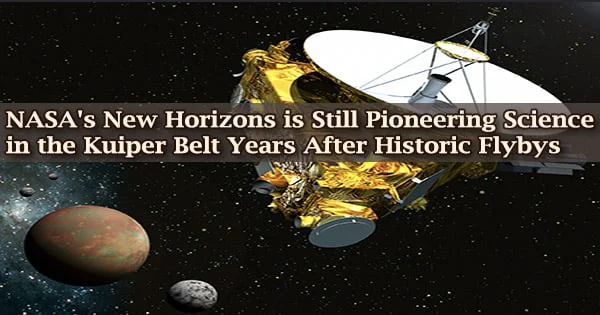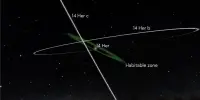To welcome in the new year, New Horizons made a spectacular flyby of a Kuiper Belt object. However, until a new batch of observations reaches Earth, the scientists behind the spacecraft won’t be able to fully comprehend the data collected during that flyby.
The observations were made by the spacecraft’s instruments between August 29 and September 5, the mission’s second observing window following the New Year’s flyby of a distant solar system object known as 2014 MU69, also known as Ultima Thule.
During the week of work, New Horizons equipment collected calibration data from a set of known stars and investigated a diverse group of outer solar system objects to answer a variety of research inquiries.
“We’ve got lots of stuff going on this is one of the busiest times we’ve had since the flyby of MU69,” Hal Weaver, project scientist for New Horizons at Johns Hopkins University’s Applied Physics Laboratory, told Space.com during the observation period. “There’s a lot on our plate over this next week, but so far, all indications are that things are working properly and the spacecraft is very busy right now.”
New Horizons is currently spinning through the vast regions of the Kuiper Belt, the ring of solar system debris around which Pluto orbits. New Horizons provides a continuous stream of data Earthward at a rate of just 2 kilobits per second while it rotates, according to Weaver. The probe’s instruments are unable to take images at this period.
After a flyby, the mission’s scientists want the spacecraft to concentrate on returning data, which will take a total of 20 months after the MU69 encounter. Even if every piece of MU69 data from New Horizons was on Earth right now, scientists wouldn’t be able to understand enough about the object without the observations from last week.
That’s why acquiring this information is worth delaying the spacecraft’s report delivery, and why some of the additional observations will take precedence over the widely anticipated MU69 data.
“We need to have those to finish the analysis of the MU69, so this data does play into that,” Alice Bowman, the New Horizons Mission operations manager at Johns Hopkins University’s Applied Physics Laboratory, told Space.com.
It’s a worrisome period for Bowman, who is in charge of the entire spacecraft’s health, because New Horizons is mostly silent while performing observations.
“It’s a little nerve-wracking for me to go days without seeing the spacecraft, because I always want to know what it’s doing,” Bowman said. “We’re pretty sure everything’s going to be fine, but I just like to see it.”
This is a long-shot observation. If we detected something, that would really be something. It would tell us that there’s a lot more grinding up of material in the Kuiper Belt, maybe a lot more objects out there than what we originally thought. But if the Kuiper Belt is behaving according to our current ideas, then we probably won’t see anything. But we thought it was worth trying.
Hal Weaver
Aside from Bowman’s worry, the findings from last week could aid mission personnel in identifying any issues with the spacecraft’s specific instruments. That’s because the instruments turned to check in on old friends, objects they’d seen many times during the mission and are known to be fairly unassuming in appearance.
The long-distance camera LORRI, which Weaver typically works with, popped over to look at NGC 3532, a star cluster that the camera has shot annually since 2013.
According to Weaver, the mission’s team does not expect to find anything particularly intriguing in the calibration data. But that is precisely the goal. New Horizons has been hurtling through space for over 13 years, and a fault could happen at any time; calibration observations are designed to warn scientists if this happens.
“This is basically a checkup for the entire observatory,” Weaver said. “Is everything still working properly? It’ll help us interpret the data we get from MU69.”
During this period of observation, scientists were able to try out a few new tricks. Weaver is particularly enthusiastic about new spacecraft commands that will increase the exposure period of the probe’s photos, according to Weaver. In order to picture the same object for more than a minute, the spacecraft’s thrusters must be fired around 80 times every minute.
“We’re always trying to think in new ways to improve the spacecraft’s capabilities as we plunge deeper into the Kuiper Belt,” Weaver said.
The team is putting the extended exposure to the test by photographing the minor planet Quaoar. If the photographs they receive are crisp and don’t have Quaoar smeared across the frame, researchers will know the approach worked.
However, don’t get your hopes up for the next spectacular astrophotography. Because of the probe’s location in the Kuiper Belt, the New Horizons observations of Quaoar are unique. That goes for the fresh information the probe has collected about Uranus and Neptune, as well as Neptune’s moon Triton and a few other Kuiper Belt objects.
Because of New Horizons’ position, its instruments see these worlds from a different angle than many of the observations astronomers have made. The many telescopes on and around Earth all observe very distant objects that are almost completely illuminated by the sun.
That’s because, on a scale of the solar system, Earth and the sun are significantly closer than planets 20 or 30 times farther out, much alone Kuiper Belt objects 40 times farther away.
New Horizons’ long trip has given it a unique perspective on these faraway worlds, allowing it to take measurements that would otherwise be unattainable. This type of observation, in particular, can aid scientists in studying the atmospheres of these worlds and determining whether they are engulfed in haze particles.
“It’s not going to look like much … the objects look like pinpoints of light,” Weaver said. “It’s not as exciting as flying right next to them, but still, we’re in a unique geometry in space and we want to take advantage of that.”
During its time in the Kuiper Belt, the New Horizons spacecraft might be flying right next to something else: dust particles generated by eons of rocky collisions in this rubble zone. Last week’s data included some attempts to find this dust, albeit New Horizons will not be able to observe any dust, according to scientists’ present knowledge of the Kuiper Belt.
“This is a long-shot observation,” Weaver said. “If we detected something, that would really be something. It would tell us that there’s a lot more grinding up of material in the Kuiper Belt, maybe a lot more objects out there than what we originally thought. But if the Kuiper Belt is behaving according to our current ideas, then we probably won’t see anything. But we thought it was worth trying.”
After a three-week stint in March, the observations collected last week constitute the second batch since the 2014 MU69 flyby. The spacecraft will benefit from longer observation periods as it investigates the Kuiper Belt objects all around it. The precise orbits of several of these bodies are unknown to scientists.
“The objects out there are very, very dim, and the spacecraft’s headed toward the galactic center, so it’s very bright,” Bowman said. “One way of increasing your chances of seeing a very dim, small object is to increase your exposure and also take a lot of images and stack them upon each other.” So the spacecraft gathers some images, waits a bit, then gathers more.
In March, those observations were focused on a Kuiper Belt object called 2014 PN70, which was the runner-up for New Horizons’ second significant flyby, but scientists decided that 2014 MU69 was a more intriguing candidate.
The spacecraft’s next period of operation will last roughly three months, commencing in early April. According to Bowman, the observations will be focused on an object known as 2011 JX31. However, because scientists have only been detecting Kuiper Belt objects for less than three decades, new targets for the probe could still be discovered.
“There’s always a possibility that new Kuiper Belt objects will be discovered that would be within the range of our camera, just like this time,” Bowman said.
New Horizons added two such objects to its September observations that were only recently identified and do not yet have formal names. Before the mission concludes, the humans in charge of New Horizons aim to squeeze in one more dramatic close flyby.
“Our scientists are trying to figure out the probability of whether or not we’re going to have something that is within the range of the propellant we have left in the tank,” Bowman said.
But none of the several space rocks that were targeted last spring, last week, or next spring will ever be able to withstand the full force of New Horizons research. They’re simply in the wrong place at the wrong time.
“Unfortunately! I would like to tell you yes,” Bowman said. “We’re still waiting.”
















